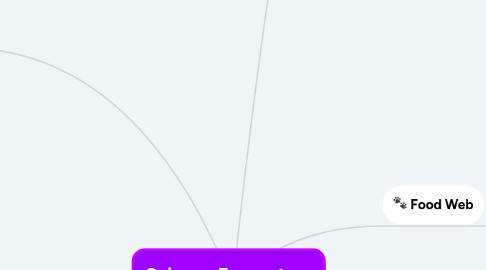
1. Human Impact
1.1. Positive: Protecting endangered species, as well as cleaning oceans, seas and lakes.
1.2. Negative: Impacts associated with use of fossil energy, water and land resources, greenhouse gas emissions, chopping down trees and etc. Some animals even lose habitats because you humans, which is called a habitat loss.
2. Animals
2.1. Endangered animals
2.1.1. Under water: Blue whales, green sea turtles, polar bears, monk seals, sea cows, porpoise.
2.1.2. Land: Gorilla, giant pandas, tigers, Sumatran Elephant, rhinos, snow leopard, red panda, red wolf.
3. (Ecosystem - Made out of living and non-living organisms that interacts with each other)
4. Underwater Ecosystem - Aquatic ecosystem
4.1. Abiotic: Sunlight, temperature, moisture, wind or water currents and soil type.
4.2. Biotic factors: Plants, animals, fungi, algae, and bacteria.
5. Food Web
5.1. It shows one producer being eaten by another consumer, or another consumer eating the first consumer. Producers are usually eaten by many different consumers, and most consumer eats more than one predator.
5.1.1. Example 1: Mallard duck eats duckweed, but they also eat tadpole, which is also something that racoons eat.
5.1.2. Example 2: Humans eat perch and fresh water clam, which are also racoon's food.
6. Vocabulary&More
6.1. Organism - An individual animal or plant (Biotic)
6.1.1. Bacteria, protozoa, plants, fungi, animals, humans
6.2. Species - A group of living organisms
6.2.1. Animals - Cats, dogs, humans, giant panda.
6.3. Population - A group of individuals of the same species occupying a paticular geographic area.
6.3.1. Forest: Population of owls, birds, pine trees.
6.4. Ecology - Branch of biology that deals with the relationship between organisms and their physical environment.
6.5. Biotic - Living things
6.5.1. How do biotic & abiotic elements interact in ecosystem: Plants uses sunlight, water and etc, which are abiotic, to survive and grow.
6.6. Abiotic - Non-living things
6.7. Habitat - A natural home or environment of animals and organisms.
6.8. Nutrients - Substance that provides nourishment for growth or metabolism. ( Plants absorb nutrients mainly from soil.
6.9. Competition - An interaction between organism or species.
6.10. Predator - Animal that eats other animals.
6.11. Prey - Animal that kills another animal for fighting for food.
6.12. Mutualism - The way two organisms of different species exist in which each individual fitness benefits from the activity of the other.
6.13. Ecosystem - Made up of living and non-living things that interacts with each other.
6.14. Primary producer - Organisms that can create their own food chain from main energy source.
6.15. Photosynthesis - Uses sunlight to synthesize foods from carbon dioxide and water.
6.16. Food chain - A model that shows how nutrients and energy flow from one organism to another in an ecosystem. It shows all the different relationships or possible energy transfers between a selected group of species.
6.16.1. Example: algae - herring - cod - seal - orca whale.

